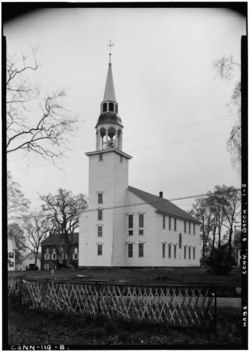
The Abington Congregational Church is a historic church on Connecticut Route 97 in the Abington village of Pomfret, Connecticut. Built in 1751 and restyled in the 1830s, it is the oldest ecclesiastical building in the State of Connecticut that has been continuously used for religious purposes. In 1977 it was included on the National Register of Historic Places.

The Old Ship Church is a Puritan church built in 1681 in Hingham, Massachusetts. It is the only surviving 17th-century Puritan meetinghouse in America. Its congregation, gathered in 1635 and officially known as First Parish in Hingham, occupies the oldest church building in continuous ecclesiastical use in the United States. On October 9, 1960, it was designated a National Historic Landmark and on November 15, 1966, it was added to the National Register of Historic Places.
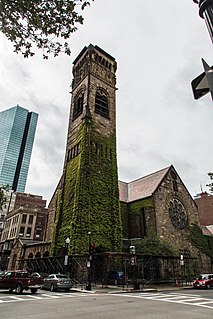
The First Baptist Church is an historic American Baptist Churches USA congregation, established in 1665. It is one of the oldest Baptist churches in the United States. It first met secretly in members homes, and the doors of the first church were nailed shut by a decree from the Puritans in March 1680. The church was forced to move to Noddle's Island. The church was forced to be disguised as a tavern and members traveled by water to worship. Rev. Dr. Stillman led the church in the North End for over 40 years, from 1764 to 1807. The church moved to Beacon Hill in 1854, where it was the tallest steeple in the city. After a slow demise under Rev. Dr. Rollin Heber Neale, the church briefly joined with the Shawmut Ave. Church, and the Warren Avenue Tabernacle, and merged and bought the current church in 1881, for $100,000.00. Since 1882 it has been located at the corner of Commonwealth Avenue and Clarendon Street in the Back Bay. The interior is currently a pending Boston Landmark through the Boston Landmarks Commission.

Trinity Church is a historic church in Brooklyn, Connecticut. Completed in 1771 and little altered since, it is the oldest Episcopal church in the state. Its congregation now meets mainly in a newer church at 7 Providence Street in Brooklyn Center, but still uses this building for special events. The building was added to the National Register of Historic Places in October 1970.
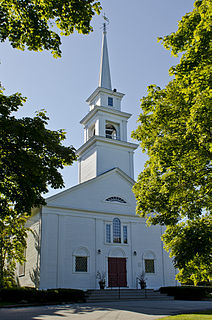
The First Trinitarian Congregational Church is a historic Congregational church at 381 Country Way in Scituate, Massachusetts; it is associated with the United Church of Christ. The Classical Revival church building was constructed in 1826 after its congregation had left the First Parish Church of Scituate when it became Unitarian in theology. The church building was added to the National Register of Historic Places in 2002.
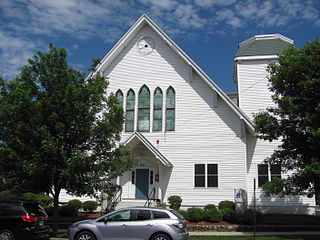
The First Unitarian Church is a historic former church building in Stoneham, Massachusetts. One of Stoneham's more stylish Gothic Revival buildings, the Stick style wood structure was built in 1869 for a Unitarian congregation that was organized in 1858. The building was listed on the National Register of Historic Places in 1984, and included in the Central Square Historic District in 1990. It presently houses the local Community Access Television organization.

The First Church in Windsor, Connecticut is the oldest Congregational church in Connecticut. Its origin can be traced back to 1630, when 140 men and women sailed out of Plymouth, England on the Mary & John. This was the first of 17 ships in the so-called Winthrop Fleet, bound for the Massachusetts Bay Colony. When they heard from the Indians about the fertile land along the Connecticut River in what is now called the Connecticut River Valley, a small contingent of settlers travelled southwest and established the first settlement in Connecticut at Windsor in 1633. Word soon spread that Windsor was a good place in which to settle: in 1635, the congregation of the First Church departed from their homes in Dorchester, Massachusetts to relocate to Connecticut.

The Evangelical Lutheran Church of St. Peter, known locally as the Old Stone Church, is located on US 9 in the Town of Rhinebeck, New York, United States. It is a stone church built in the late 18th century by the area's Palatine German immigrant population. It has been renovated significantly since then. The church congregation was established in 1729.

The Long Society Meetinghouse is a historic church building at 45 Long Society Road in Preston, Connecticut. It is one of only about a dozen surviving colonial "broad side" meeting houses, and is the last example surviving in Connecticut that has not been altered from that configuration by the addition of a tower or relocation of its entrance or pulpit. The meeting house was built from 1817 to 1819 on the site of an earlier meetinghouse, incorporating some elements of the earlier building. The meeting house was used both as a church and for civic functions, the reason for its plain, not overtly religious appearance. The building was added to the National Register of Historic Places in 1976.

The South Canaan Congregational Church is a historic Congregational church building at Connecticut Route 63 and Barnes Road in the town of Canaan, Connecticut. Built in 1804, it is a remarkably well-preserved example of early Federal period church architecture. It was listed on the National Register of Historic Places in 1983.

St. John's Episcopal Church is a historic church at 92 Main Street in the Warehouse Point section of East Windsor, Connecticut. Built in 1804, its interior was extensively restyled in the second half of the 19th century to resemble a Gothic English country church. The building, still in active use by the original congregation, was listed on the National Register of Historic Places in 1982.

The Center Meetinghouse is a historic meetinghouse on NH 103 in Newbury, New Hampshire. The Federal-style church building was built c. 1832, a relatively late date for the style. It replaced a 1797 meetinghouse that had been located about a mile away. It is further believed to be distinctive in New Hampshire as the only Federal period church in which the pulpit is located at the rear of the auditorium. Originally built to be used by multiple religious denominations, it is now operated by a local nonprofit organization as a community center. It was listed on the National Register of Historic Places in 1979.

The Lower Warner Meetinghouse is a historic meetinghouse at 232 East Main Street in Warner, New Hampshire. Built in 1844-45, it is a little-altered example of a 19th-century Greek Revival church, which has retained nearly all of its original interior elements, as well as its exterior except for the steeple, lost to a lightning strike c. 1893. It was listed on the National Register of Historic Places in 1989.
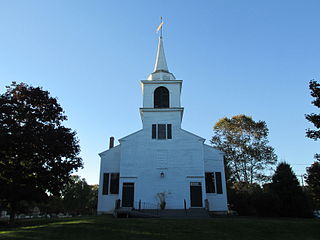
The First Congregational Church of Buxton, also known locally as the Tory Hill Meetinghouse, is a historic church on ME 112 in Buxton, Maine. Built in 1822, it is an example of Federal period architecture, having had only modest alterations since its construction.

The First Universalist Church, also once known as the Central Parish Church, is a historic church at 97 Main Street in Yarmouth, Maine. Built in 1859-60, it is an excellent local example of religious Italianate architecture, and one of the state's few surviving churches designed by architect Thomas Holt. It was listed on the National Register of Historic Places in 1988. The congregation was founded in 1859, and is affiliated with the Unitarian Universalist Association; its current minister is Rev. Hillary Collins-Gilpatrick.
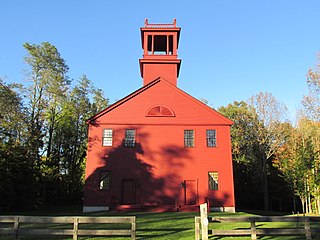
The First Parish Meetinghouse, also known as the Old Red Church, is a historic church building on Oak Hill Road in Standish, Maine. Built 1804-06, it is a well-preserved example of rural Federal period design. The building has served the community as a church and school, and is still occasionally used for religious services. It was listed on the National Register of Historic Places in 1975.

The Bingham Free Meetinghouse is a historic church on South Main Street in Bingham, Maine. Built in 1835-36, this wood frame structure was the first church to be built north of Caratunk Falls in northwestern Maine. The building is architecturally transitional, exhibiting both Federal and Gothic Revival elements. It was listed on the National Register of Historic Places in 1976.

The Georgia Plain Baptist Church is a historic church in Georgia, Vermont. Built in 1877 for a congregation established in 1793, it is a well-preserved example of High Gothic Victorian architecture. It was listed on the National Register of Historic Places in 2001. The congregation is affiliated with the American Baptist Churches of Vermont and New Hampshire.

The East Village Meetinghouse, also known as the Old Brick Church, is a historic church at 55 Vermont Route 14 in East Montpelier, Vermont. Built in 1833-34, it is a fine local example of Greek Revival architecture, and has been the focal point of the historic East Village for most of its history. It was listed on the National Register of Historic Places in 1980.
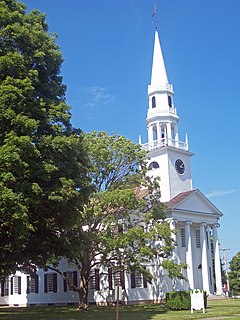
The First Congregational Church of Litchfield is a congregation of the United Church of Christ in Litchfield, Connecticut, USA, occupying a historic building on the Litchfield green.
